Honeybees are known for their sweet nectar and delicious honey, but they also have a sting that can cause pain and discomfort. Honeybee stings are usually not dangerous unless the person stung is allergic to the venom. However, even if you are not allergic, a honeybee sting can cause pain, swelling, and redness at the site of the sting. Knowing how to treat a honeybee sting can help alleviate these symptoms.
What to do when stung by a honeybee?
If you get stung by a honeybee, the first thing you should do is remove the stinger. The stinger is usually still attached to the bee, and it looks like a tiny black dot. Use a straight edge, like a credit card, to scrape the stinger out of your skin. Do not try to pull it out with your fingers, as this can cause more venom to be released into your skin.
After removing the sting, cleanse the stinged region with the help of water and some antioxidants. This will help to reduce the risk of infection. You can also apply a cold compress, like a bag of ice or a cold, damp cloth, to the area to help reduce swelling and pain.
Home remedies for honeybee sting
- If you are looking for natural remedies for honeybee sting, there are several things you can try at home. One of the most effective remedies is to apply a paste made of baking soda and water to the affected area. Mix a small amount of baking soda with enough water to make a paste, and then apply it to the sting. Keep the wound uncovered for fifteen to twenty minutes and then wash it.
- Another home remedy is to apply aloe vera gel to the sting. The natural herb aloe vera has multiple anti-inflammatory characteristics that treat in reducing swelling and pain. Simply apply a small amount of aloe vera gel to the sting and leave it on for as long as necessary.
- If you don’t have baking soda or aloe vera gel, you can try applying honey to the sting. Honey has antibacterial properties that can help to prevent infection, and it can also help to soothe the skin. Simply apply a small amount of honey to the sting and leave it on for 30 minutes before washing it off.
When to see a doctor?
Most honeybee stings can be treated at home, but in some cases, medical attention may be necessary. You need to look for a medical aid if you experience any
- Difficulty breathing or swallowing
- Swelling of the face, lips, or throat
- Dizziness or lightheadedness
- Rapid heartbeat or palpitations
- Hives or rash
These symptoms could indicate a severe allergic reaction to the bee venom, which can be life-threatening if left untreated.
How to prevent honeybee stings?
The best way to avoid honeybee stings is to avoid disturbing their nests. If you see a bee buzzing around, try to remain calm and still. Bees are less likely to sting if they do not feel threatened.
If you are going to be spending time outdoors, especially in wooded areas or near flowers, it is a good idea to wear protective clothing, like long sleeves and pants. You can also apply insect repellent to help deter bees from coming near you.
Concluding With
Pritish Kumar Halder also known as Pritish Halder shares his set of information for different fields. Here he concludes with, honey bee stings can be painful and uncomfortable, but they are usually not dangerous unless you are allergic to the venom. Knowing how to treat a honeybee sting can help alleviate the symptoms and prevent infection.





